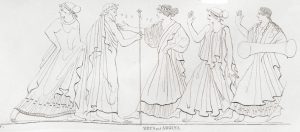Chapter 6: Other Early Families
Previous Page Table of Contents Next Page
♠ Il 4.382-84 – Homer, Iliad
So when they had departed and were with deep reeds, that coucheth in the grass, there did the Achaeans send forth Tydeus on an embassage. Greek Text
♠ Il 10.285-88 – Homer, Iliad
Follow now with me even as thou didst follow with my father, goodly Tydeus, into Thebes, what time he went forth as a messenger of the Achaeans. Them he left by the Asopus, the brazen-coated Achaeans, and he bare a gentle word thither to the Cadmeians. Greek Text
♠ Od 11.260-63 – Homer, Odyssey
And after her I saw Antiope, daughter of Asopus, who boasted that she had slept even in the arms of Zeus, and she bore two sons, Amphion and Zethus, who first established the seat of seven-gated Thebe. Greek Text
♠ ApB 3.12.6 – Apollodoros, Bibliotheke (Library)
The Asopus river was a son of Ocean and Tethys, or, as Acusilaus says, of Pero and Poseidon, or, according to some, of Zeus and Eurynome. Greek Text
♠ Akousilaos FGrH 2F21 – Die Fragmente der griechischen Historiker 1, p. 52, ed. F. Jacoby. 2d ed. Leiden 1957.
♠ Hesiod, Aigimios fr 294 MW – Fragmenta Hesiodea, pp. 151-52, ed. Merkelbach and M.L. West. Oxford 1967.
♠ Eumelos, Europia fr 10 PEG – Poetae Epici Graeci 1, p. 112, ed. A. Bernabé. Leipzig 1987.
Vatican City, Museo Gregoriano Etrusco 16526: Attic red-figure stamnos by Hermonax with Zeus pursuing Aigina, and her father Asopos (all named)


E. Braun, Antike Marmorwerke: 1. u. 2. Decade (1843), pl. 6
Beazley Archive Pottery Database
New York, Metropolitan Museum of Art 96.19.1: Attic red-figure column krater with Zeus with thunderbolt pursuing Aigina (named)

G.M.A. Richter and L. F. Hall, Red-Figured Athenian Vases in the Metropolitan Museum of Art (1936), pl. 94

Beazley Archive Pottery Database
♠ Nem 8.6-12 – Pindar, Nemean Odes
such loves, the shepherds of Cyprian Aphrodite’s gifts, attended the marriage-bed of Zeus and Aegina. And from that union a son was born, the king of Oenone, the best in hands and mind. Many men often prayed that they might see him; for, unbidden, the choicest heroes that dwelled around him [10] wanted to submit to his commands willingly, those who marshalled their people in rocky Athens, and the descendants of Pelops in Sparta. Greek Text
♠ Is 8.17-23 – Pindar, Isthmian Odes
For as twin daughters they were born to the same father, the youngest of Asopus’ children, and they were pleasing to Zeus the king. He caused one of them to dwell beside the beautiful stream [20] of Dirce, to lead a chariot-loving city; but he carried you to the island Oenopia and slept with you there, where you bore Aeacus, the dearest of all men on earth to the loud-thundering father. Greek Text
♠ Pindar, Paian 6.134-40 – Pindarus 2, p. 30, ed. B. Snell and H. Maehler. Leipzig 1975.
♠ Pherekydes FGrH 3F119 – Die Fragmente der griechischen Historiker 1, p. 92, ed. F. Jacoby. 2d ed. Leiden 1957.
♠ ApB 3.12.6 – Apollodoros, Bibliotheke (Library)
In search of her Asopus came to Corinth, and learned from Sisyphus that the ravisher was Zeus. Asopus pursued him, but Zeus, by hurling thunderbolts, sent him away back to his own streams. Greek Text
♠ H 4.77-78 – Kallimachos, Hymns – Callimachus 2, p. 21, ed. R. Pfeiffer. Oxford 1949.
♠ Nonnos, Dionysiaca 7.180-83
Erinys the Avenger flying by in the air saw Semele bathing in the waters of Asopos, and laughed as she thought how Zeus was to strike both with his fiery thunderbolt in one common fate. Greek Text
Previous Page Table of Contents Next Page
Literary sources edited by Elena Bianchelli, Retired Senior Lecturer of Classical Languages and Culture, Univ. of Georgia, February 2024.
874 total views, 2 views today